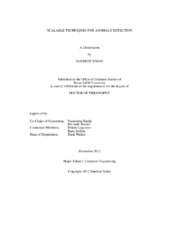| dc.description.abstract | Computer networks are constantly being attacked by malicious entities for various reasons. Network based attacks include but are not limited to, Distributed Denial of Service (DDoS), DNS based attacks, Cross-site Scripting (XSS) etc. Such attacks have exploited either the network protocol or the end-host software vulnerabilities for perpetration. Current network traffic analysis techniques employed for detection and/or prevention of these anomalies suffer from significant delay or have only limited scalability because of their huge resource requirements. This dissertation proposes more scalable techniques for network anomaly detection.
We propose using DNS analysis for detecting a wide variety of network anomalies. The use of DNS is motivated by the fact that DNS traffic comprises only 2-3% of total network traffic reducing the burden on anomaly detection resources. Our motivation additionally follows from the observation that almost any Internet activity (legitimate or otherwise) is marked by the use of DNS. We propose several techniques for DNS traffic analysis to distinguish anomalous DNS traffic patterns which in turn identify different categories of network attacks.
First, we present MiND, a system to detect misdirected DNS packets arising due to poisoned name server records or due to local infections such as caused by worms like DNSChanger. MiND validates misdirected DNS packets using an externally collected database of authoritative name servers for second or third-level domains. We deploy this tool at the edge of a university campus network for evaluation.
Secondly, we focus on domain-fluxing botnet detection by exploiting the high entropy inherent in the set of domains used for locating the Command and Control (C&C) server. We apply three metrics namely the Kullback-Leibler divergence, the Jaccard Index, and the Edit distance, to different groups of domain names present in Tier-1 ISP DNS traces obtained from South Asia and South America. Our evaluation successfully detects existing domain-fluxing botnets such as Conficker and also recognizes new botnets. We extend this approach by utilizing DNS failures to improve the latency of detection. Alternatively, we propose a system which uses temporal and entropy-based correlation between successful and failed DNS queries, for fluxing botnet detection.
We also present an approach which computes the reputation of domains in a bipartite graph of hosts within a network, and the domains accessed by them. The inference technique utilizes belief propagation, an approximation algorithm for marginal probability estimation. The computation of reputation scores is seeded through a small fraction of domains found in black and white lists. An application of this technique, on an HTTP-proxy dataset from a large enterprise, shows a high detection rate with low false positive rates. | en |


